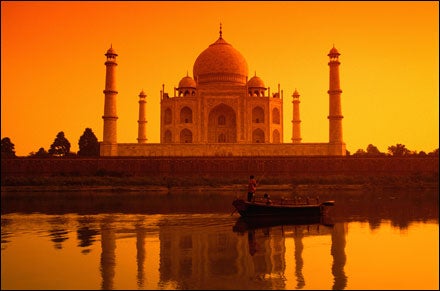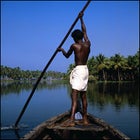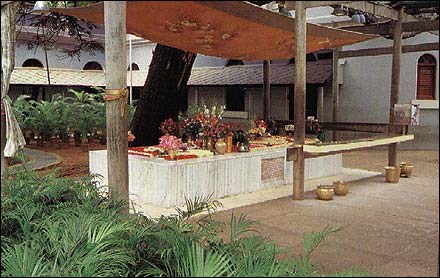BEST ASHRAM
Sri Aurobindo/Auroville, Pondicherry
Throw a mango anywhere in India—the birthplace of yoga—and you’ll hit an ashram. Officially designated as a place for spiritual striving, these retreat centers range from spare mountain meditation chambers to urban yoga Disneylands. There’s no better representation of ashram life, however, than Auroville, a humming township near the former French colony of Pondicherry, in tropical Tamil Nadu. Spread out along the warm Bay of Bengal, the eight-square-mile town is being built by followers of the famous guru Sri Aurobindo and his French partner, a woman known as “the Mother.” The Aurovillians have constructed an internationally populated utopia of organic farms, holistic hospitals, arts-and-crafts centers, and hatha yoga instruction.
Ease into your tour of all things Auroville with sunrise “integral” yoga—more meditative than stretching—at the original Sri Aurobindo Ashram in Pondicherry. Catch a hearty ayurvedic meal of rice idlis, coconut chutney, and banana-flower sambar at the Solar Kitchen (run partly by solar energy) and get the best yoga instruction in the state at the Quiet Healing Centre. Finally, try a session on the “sound bed”: an oversize, Indian-style guitar that you lie inside while it’s played—like an iPod for your soul. DETAILS: Accommodations, $35–$50;
Best Pilgrimage
Varanasi
At Manikarnika Ghat, I became so mesmerized watching the fires devouring the human bodies that I was startled when a vagabond approached: “Sir, 150 dead are cremated here every day, and they become enlightened.” Barefoot workers were preparing the pyres, sprinkling incense on the dead, setting them alight. “Sir, you like charas?” he asked, meaning hashish.
Apparently Lord Shiva, the Hindu god of destruction, is an avid marijuana user, so hashish is widely tolerated in India. But I was in town for more temporal allures: to witness some of the millions of pilgrims who pour annually into this 3,000-year-old city. Hindus come to cleanse themselves of sin in the sacred Ganges River. Better still is the prospect of dying in the river, for the City of Light is doubly holy as the only place on the planet where all five elements converge: water, wind, sky, earth, and the “eternal fire” that has been kept lit for 2,000 years. According to Hindu beliefs, passing away in these waters leads to liberation from the cycle of reincarnation.
After dinner on the rooftop restaurant at Palace on the Ganges, a hotel outside the old town, I returned to the fray mid-evening. The pilgrims—women in peacock-colored saris, sadhus in steel chastity belts, the old and the sick yearning for death—cut a timeless scene among the riverfront assembly. Mantras blared from temple loudspeakers, and the streets were choked by homeless pilgrims, aggressive touts, morose cows, and cycle rickshaws. Elsewhere I would have felt overwhelmed by the clamor. But here I was unwittingly infused with the city’s energy of exultation—part of the reason, no doubt, that a trip to India feels incomplete without a visit to Varanasi. DETAILS: Doubles at Palace on the Ganges from $70; 011-91-542-2315050
Best Bike Tour
Leh to Manali, Ladakh
Ladak
 Ladak
LadakI mountain-bike for the downhill, which is why I was thrilled when I heard about riding in the Himalayas: 20-plus-mile descents. So I headed for India’s northwestern state of Ladakh, home to some of the most remote bike touring—and biggest downhills—in the world.
At 11,500 feet, the town of Leh—where I met up with a dozen other cyclists on a tour with Aspen-based outfitter KE şÚÁĎłÔąĎÍř Travel—sits over 1,300 feet above the highest incorporated town in the United States (Leadville, Colorado). In three weeks, we would cross 480 miles and four high-mountain passes, including two above 17,000 feet, in a traverse to the border town of Manali. First up was the Khardung La, the highest motorable pass in the world. We pedaled our way up the switchbacks and eventually came to a greasy sign: HIGHEST ROAD IN THE WORLD, HT. 18,380ft.—YOU CAN HAVE DIALOGUE WITH GOD. The only dialogue I was having was internal: What were you thinking? I was enduring altitude headaches, nausea, and total fatigue. But that all seemed trivial compared with the scenery. We spun from wide-open desert to high-alpine vistas with receding glaciers and rocky moraines. We passed fantastically eroded mud-and-rock sculptures and cycled along vibrant turquoise rivers. At one point, we zipped through 22 hairpin turns on tight switchbacks, descending more than 10,000 feet—all before lunch!
On our final day, atop a pass overlooking the Kulu Valley in Himachal Pradesh, we ate cheese sandwiches and boiled potatoes with the Karakoram at our feet. Then one last thrill: We mounted our bikes and flew back down to Manali, a final zinging descent of more than 20 miles. DETAILS: Trips cost $2,795, departing in July; 800-497-9675,
Best Icon
Taj Mahal, Agra

I wanted to skip the Taj Mahal—India, with its bustling chaos of people, animals, cultures, and foods, is one enormous, living monument, so why bother with an overcrowded building? On the insistent urging of some fellow travelers, however, my partner, Jen, and I changed our itinerary and veered for Agra.
Passing through the pink sandstone entry gates, all our misgivings evaporated: ClichĂ© or not, the Taj Mahal must be seen. Every admiring accolade you’ve read about the Taj—the perfect symmetry of the structure; the way the marble glows rose at dawn and saffron at sunset; the semiprecious-stone inlay fitted so tightly that the seams are imperceptible—it’s all true. Equally inspiring is the story behind the structure: Shah Jahan, crowned king of the Mughals in 1628, at the height of the empire, built the Taj as a final resting place and monument for his wife, Mumtaz Mahal, at her deathbed behest. And since the Taj got a face-lift in 2002—with the removal of decades-old stains and grime—it is as sparkly and impressive as ever.
Jen and I had to wait to take it all in. The moment we stepped onto the Taj’s marble platform, a young Indian family approached and asked to take our photo—with them in the picture. Slightly uneasy, we agreed. After a moment, another family approached, then another, until a queue of enthusiastic Indians had formed. A guide later explained that, among some rural Indians, bringing home glossies of themselves with their “Western friends” gives them village bragging rights. One uninhibited group placed Jen and me amid the clan of 16, holding the baby, naturally; seconds before the flash went off, a hand appeared from behind me and pinched my smiling cheek. To this day, I keep a copy of the photo, a souvenir nearly as memorable as the Taj itself.
Best Safari
Kaziranga National Park, Assam
Kaziranga National Park
 Kaziranga National Park Rhino
Kaziranga National Park RhinoMy sweetheart and I had been chasing curves on National Highway 37, in the remote northeastern state of Assam, for five hours when we spotted the first elephant-crossing sign on the edge of Kaziranga National Park. As if on cue, our driver swerved to an overlook, revealing a herd of Indian elephants feasting on a 12-foot-tall stand of elephant grass. It was an auspicious first encounter with the famed megafauna of Kaziranga.
Located on the banks of the Brahmaputra River, the swampy 106,000-acre Kaziranga National Park is home not only to wild tuskers but also to globally threatened species like the majestic Bengal tiger and the Indian one-horned rhino. There is no better place on earth to see the myopic, armor-skinned, minivan-size beasts Marco Polo allegedly mistook for unicorns. In fact, the preserve’s 1,650 rhinos represent two-thirds of the species’s global population.
Touring the park by jeep, not only did we encounter rhinos and elephant herds; we crossed paths with water buffalo and even monitor lizards. On day two of our tour, an outwardly docile ten-foot-long tiger emerged and lay insouciantly on the road. That evening, we relived our sightings over cocktails at a rustic eco-lodge near the park boundary, Wild Grass Resort, which hosted Monty Python alum and world traveler Michael Palin during his research for the 2004 BBC series Himalaya. Owner Manju Barua, an outspoken conservationist, has banned TV at the lodge. But with each day unfolding like an episode of Wild Kingdom, you won’t miss it. DETAILS: Doubles from $60; 011-91-3776-2662085,
Best Trek
Darma Valley, Uttaranchal
Uttaranchal mountains
 Uttaranchal mountains
Uttaranchal mountainsGiven the civil war festering in nearby Nepal, and the tourists crowding India’s trekking routes in Ladakh and Sikkim as a result, I opted for a trip in the little-known Darma Valley. Sitting above 10,000 feet, and bounded by Nepalese peaks to the east and the Tibetan Plateau to the north, the valley is one of the subcontinent’s last unexplored trekking alternatives.
It’s also India’s equivalent to Idaho—and home to a population of pastoral mountain people. For centuries, the families of the Darma Valley have made a summer migration from the remote river town of Dharchula to their slate-roofed Himalayan valley homes, where they herd sheep and farm potatoes, buckwheat, and other grains. When the work is done, the villagers make sacrifices to the gods, play music, and toss back rice wine and a tangy wheat beer. We timed our trip to coincide with the festivities.
After the 250-mile bus ride from Delhi, we faced a lung-busting 30 miles of hiking beneath the needle-sharp peaks of the Panchachuli Range, all five over 20,000 feet, to the turnaround at Panchachuli Glacier. From there, we could either double back down the valley or continue over snowy passes: An eastern circuit flanks the holy 22,028-foot peak of Kailas, while the western valleys edge past 25,645-foot Nanda Devi, where British climbing stars Eric Shipton and Bill Tilman staked their claim to fame in 1934. Ill prepared for glacier travel, we turned back at the Stone Age village of Sipu, at 11,280 feet one of the highest Darma settlements, content to tap the local brew. DETAILS: Book May–June or September–November; KMVN outfitter can arrange a seven-day trip for $81; 011-91-5942-236356,
Best Palace Hotel
Fort Tiracol, Goa
The classic 18th-century grand palaces of Rajasthan get all the glory, but a newer noteworthy alternative is Goa’s historic Fort Tiracol, on the Arabian Sea, where Santa Fe styling meets South Indian hospitality. Set on the headlands where the Tiracol River meets the sea, the 16th-century former Portuguese fort was stylishly revamped in 2002 by Hari Ajwani, a Bombay-bred heritage hotelier, and his wife, German stylist Claudia Derian. Built around a small courtyard, the property has seven airy rooms with rustic wood and wrought-iron furnishings, while the vast poured-concrete bathrooms offer possibly the most luxurious toileting experience on the subcontinent. To wit, picture windows overlook the ocean, while the bathrooms themselves are as large as bedrooms in many modern hotels across India.
The property is a good base for exploring the party-hearty beaches of northern Goa. But if you’re sick of rubbing elbows with the hordes of sunbathers, Tiracol also has its very own secluded option: On Querim Beach, a private white-sand cove ringed by palm trees, my travel companion Christina and I had only sea turtles for company. But Goa isn’t all about chilling. Rent a scooter and explore the winding roads of Maharashtra or head to Arambol and try paragliding off the bluffs. Don’t miss the madhouse flea market each Wednesday at Anjuna, which draws merchants selling silk, crafts, and silver jewelry.
After a trip to the market, Christina and I returned to the upstairs lounge at Fort Tiracol, where we snacked on spicy grilled seafood and basked like royalty before another spectacular Arabian Sea sunset. Tiracol hasn’t yet garnered the notoriety of the palaces of the north—and good thing. DETAILS: Doubles from $140, including full board; best season is October–May; 011-91-2236-227631, nilaya@sancharnet.in
Best Hill Station
Darjeeling, West Bengal
Buddhist prayer flags snap in the breeze, while jagged Himalayan peaks play hide-and-seek in the cloudy distance. It’s my second day in Darjeeling, a quintessential South Asian hill station. The colonial British and their Indian counterparts once escaped the scorching summer temps on the plains by heading for this most famous of summer capitals. These days, travelers find respite in these cool hills.
Like generations of explorers, I’ve come to bag a few nearby peaks. First stop is the Himalayan Mountaineering Institute, once presided over by the late Everest pioneer Tenzing Norgay, which offers outdoor courses (and has a museum stuffed with alpinism memorabilia). Hoping to follow in Norgay’s bootsteps, I I book a multiday trek and set off into the nearby hills.
Even for those without high-altitude designs, Darjeeling is a worthwhile stopover. The town has a flavor as distinct as the tea grown on its outskirts, seasoned not just by Raj-era architecture, bakeries, and antique shops but also by a heady dose of Himalayan cultures—Nepal, Bhutan, and Sikkim are all next door. In town, the Hotel Windamere, a 19th-century Heritage Hotel overlooking Chowrasta Square, provides local color and great views. DETAILS: Doubles from $145, with full board; 011-91-354-2254041, .
Best River
Brahmaputra, Arunachal Pradesh
River Boat
 River Boat
River BoatIn 2002, Vaibhav Kala, owner of Aquaterra şÚÁĎłÔąĎÍřs, hatched an audacious plan to offer the first-ever commercial expedition down the 110-mile upper stretch of the Brahmaputra, which flows from Tibet through Arunachal Pradesh, in far northeastern India. Locally known as the Siang, the Class IV+ Brahmaputra rivals the Grand Canyon when it comes to whitewater, with the added attraction of exotic tribes that rarely see outsiders. Today, with other companies looking to follow Aquaterra’s lead, the Brahmaputra float is on the verge of becoming India’s splashiest big-water adventure.
Reaching the put-in remains a challenge unto itself, requiring a 50-mile upstream motorboat transfer from Dibrugarh, followed by a two-day jeep ride into the jungle of Arunachal Pradesh from neighboring Assam. Up next are seven days of wilderness paddling, with the verdant scenery punctuated by huge Class III–IV+ rapids on a scale more reminiscent of The Perfect Storm than The River Wild. DETAILS: For now, Aquaterra offers the only set departures on the Brahmaputra; November 24–December 8; kayaking from $3,100, rafting from $3,600; 011-91-11-29212641,
Best Festival
Pushkar Camel Fair, Rajasthan
You haven’t lived until you’ve communed with camels, which is why you can’t miss the Pushkar Camel Fair, a mind-blowingly biblical convergence of camels, camel traders, mystics, and musicians, all camped out in Rajasthan’s Thar Desert. For centuries, during the month of Kartik (the eighth lunar month of the Hindu calendar, falling roughly around October and November on the Gregorian calendar), Rajasthan’s camel herders have trekked to the town of Pushkar in time for the full moon. This year’s fair (November 2–5) will bring about 200,000 people and 50,000 camels to the desert bash.
At the fair you’ll find a sea of khaki-brown sand dunes pitched with dung-colored tents and entire families camped out: Hindu men in turbans, Rajasthani tribal women in color-drenched skirts and saris, kids hawking everything from camel bells to camel-cart rides. You’ll also find camels—and lots of them: babies with spindly legs and big, goofy heads; teenage camels; worn-out camels; camels standing; camels sleeping; camels adorned with braids, tassels, and tattoos. You can ride camels, watch camel races, or witness the business of camel trading up close. (Want to take home a new pet? A three-year-old camel goes for around 25,000 rupees—or $567.)
Stay at the Royal Camp, upscale tented lodging pioneered by the Maharaja of Jodhpur in the 1990s, just a few dunes from the festivities. Each safari-style, canvas tent has twin beds with crisp white linens, a front porch with teak chairs, a private bath, and buckets of hot bathwater delivered to your door. DETAILS: Doubles from $250, including meals; 011-91-291-2571991,
BONUS: Best Escape from India
Bangaram Island Resort, Lakshadweep Islands
Lakshadweep Islands
 Lakshadweep Islands
Lakshadweep IslandsThe battering madness of India’s cultural mosh pit can exhaust even the most seasoned traveler, which is why many Indians advise leaving the mainland to truly appreciate its charms. There’s no better place to get this critical break—without passing through customs—than the isolated, talcum-beached coral atoll of Bangaram, one of 26 tiny coconut-palm islands that make up the Lakshadweep archipelago, in the Arabian Sea.
Of the three islands open to tourists, Bangaram Island Resort—which owns the entirety of the island—boasts the least development, with only 34 teak-and-tile bungalows spread tastefully throughout the island’s 128 acres. After you’ve settled into a private hut, stumble a few feet across the snowy beach to fin through crystal waters. The sea life is so accommodating that the resort asks divers to refrain from riding the massive sea turtles and manta rays that lounge around the house reef.
For more adventurous fauna, house dive masters will take you to deeper reaches, including a sheer limestone chasm known as the Grand Canyon. Deeper still, fishermen will find wahoo and sailfish that are the stuff of Hemingway lore. Or pass on it all and spend an afternoon in a silent hammock for that much-needed perspective on India. DETAILS: Bungalows, $290–$350 all- inclusive; 011-91-484-2668221,



